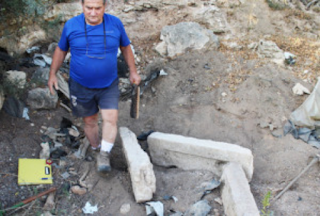From the algemeiner.com
JNS.org – Three 1,700-year-old funerary inscriptions referring to “rabbis” were discovered in Moshav Zippori in Israel’s Galilee region, a finding that affirms a Jewish presence in Israel during the Roman period, the Israel Antiquities Authority (IAA) announced Wednesday.
“The importance of the epitaphs lies in the fact that they reflect the everyday life of the Jews of Zippori and their cultural world,” said Dr. Motti Aviam of the Kinneret Institute for Galilean Archaeology, which partnered with the IAA on the discovery.
Two of the Aramaic inscriptions were found buried in a cemetery in Zippori, but their names have not yet been deciphered. One of the inscriptions bears the name “The Tiberian,” Aviam said.
“This is already the second instance of someone from Tiberias being buried in the cemetery at Zippori,” said Aviam. “It is quite possible that Jews from various parts of Galilee were brought to Zippori to be buried in the wake of the important activity carried out there by [the Mishnah-era sage] Rabbi Yehuda Ha-Nasi.”
Follow us on 





